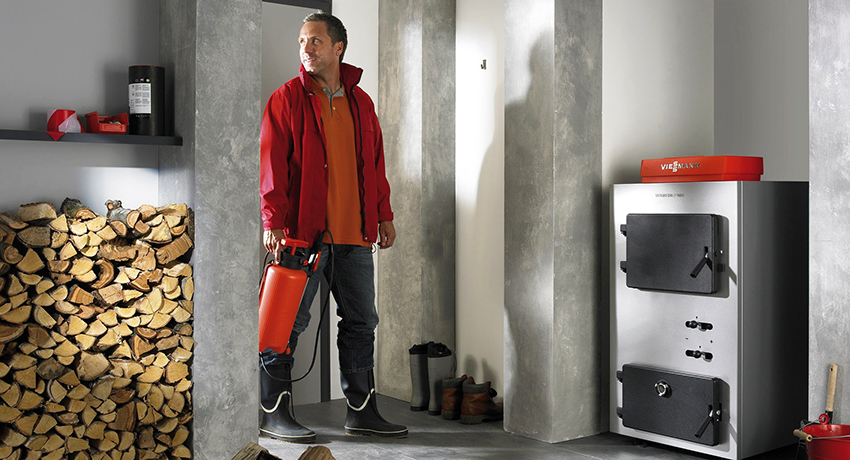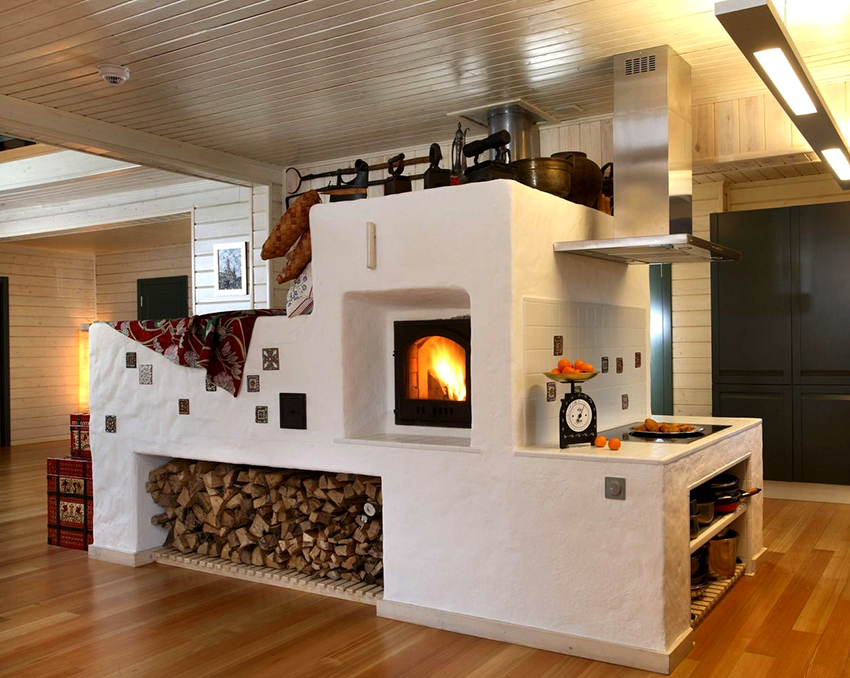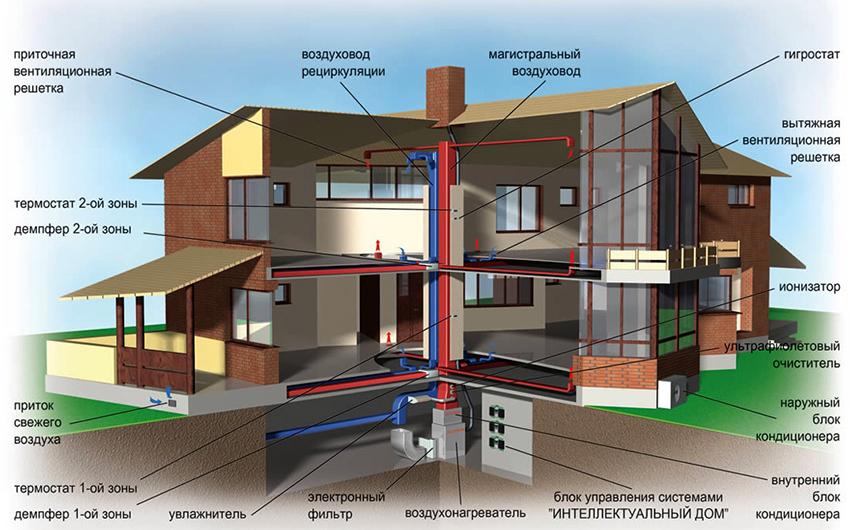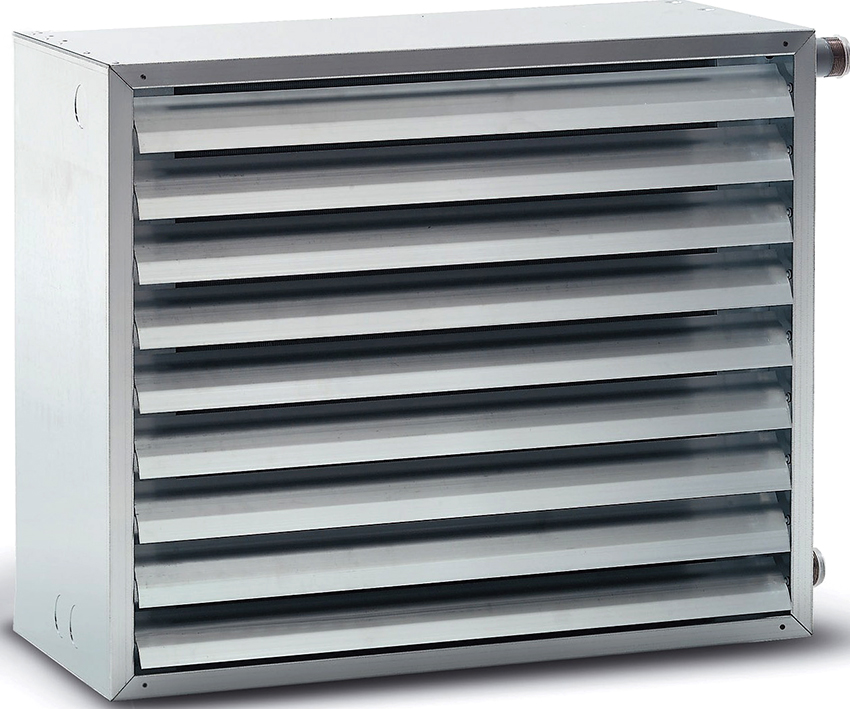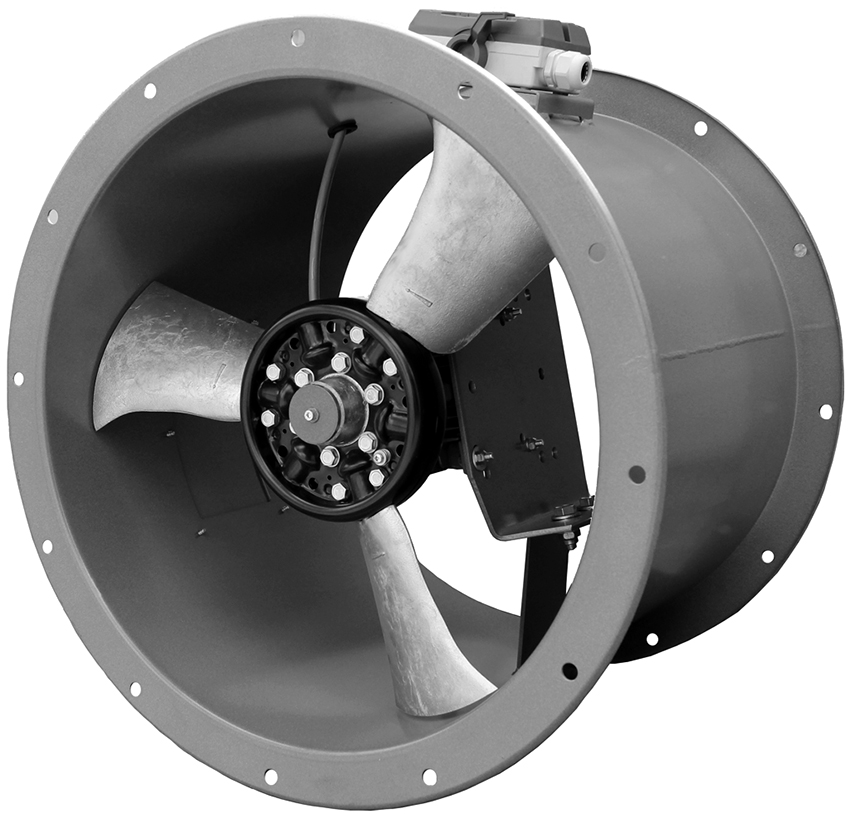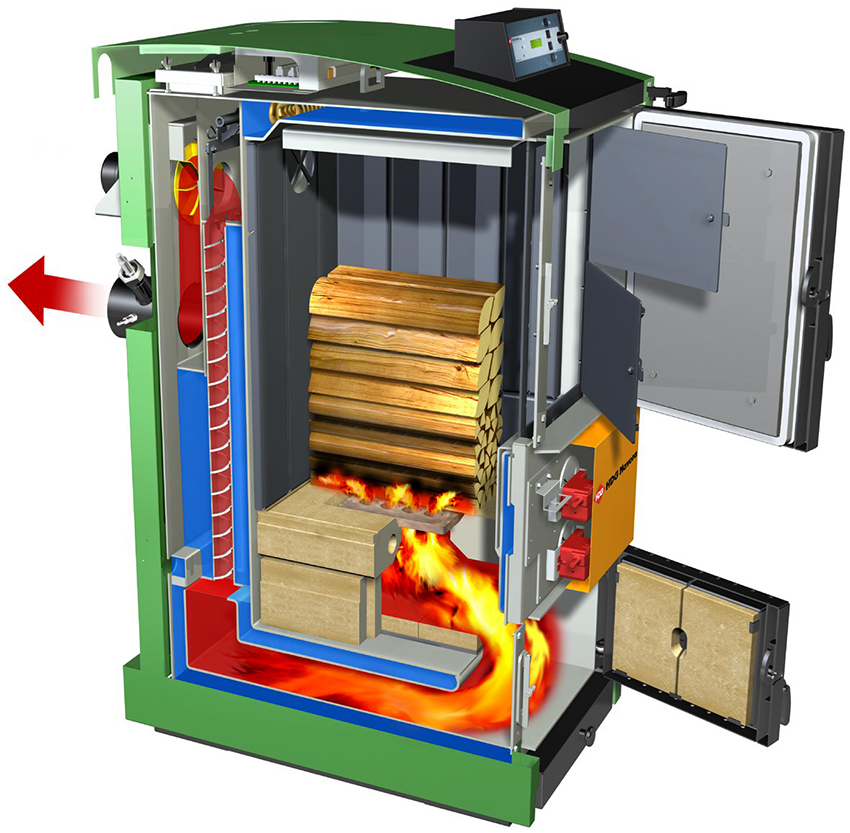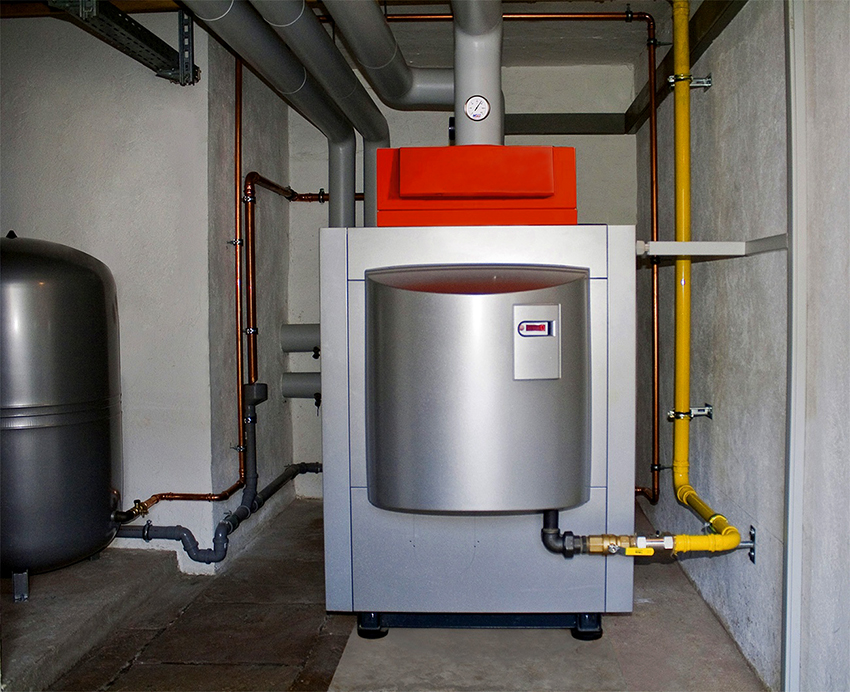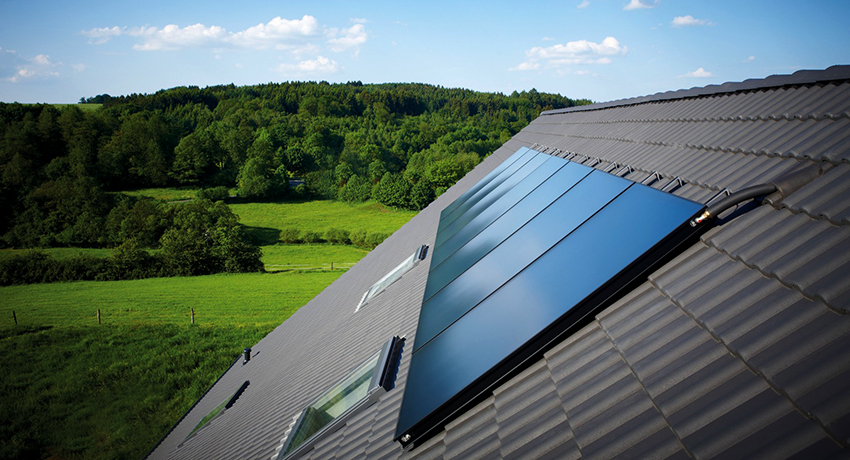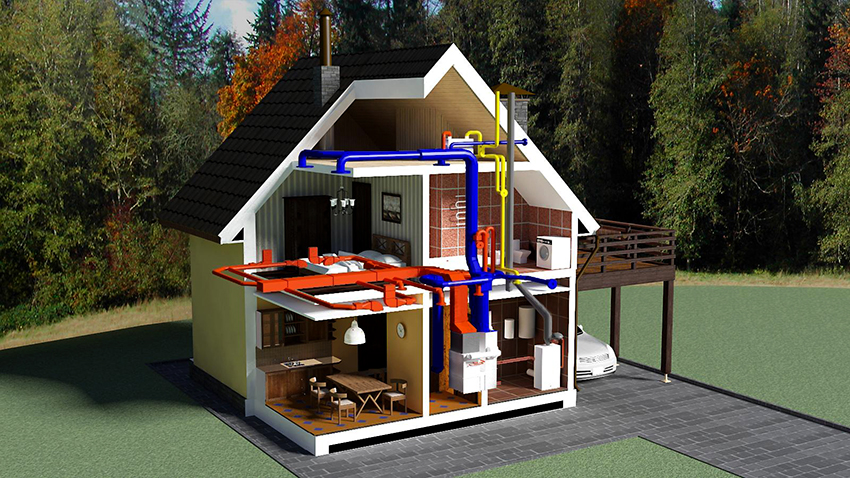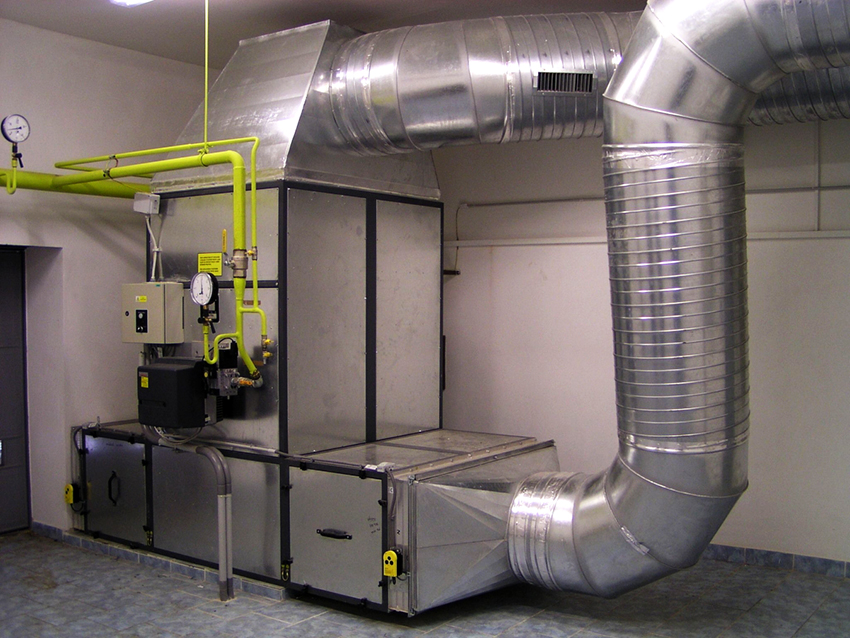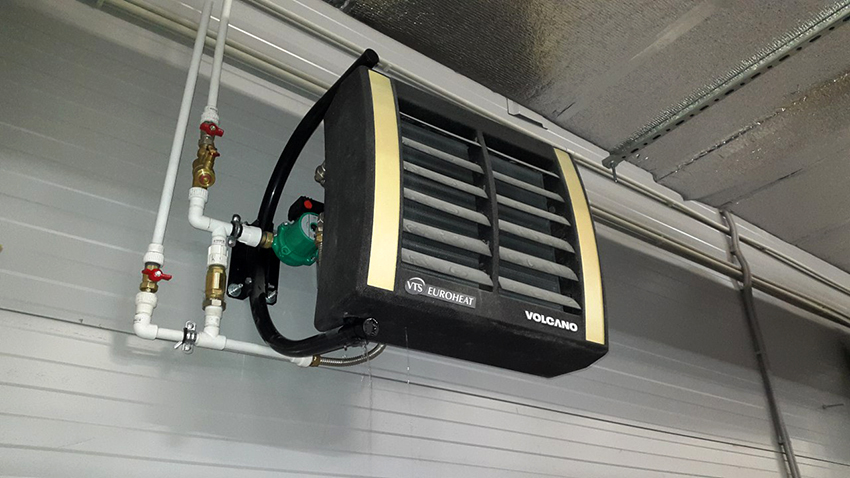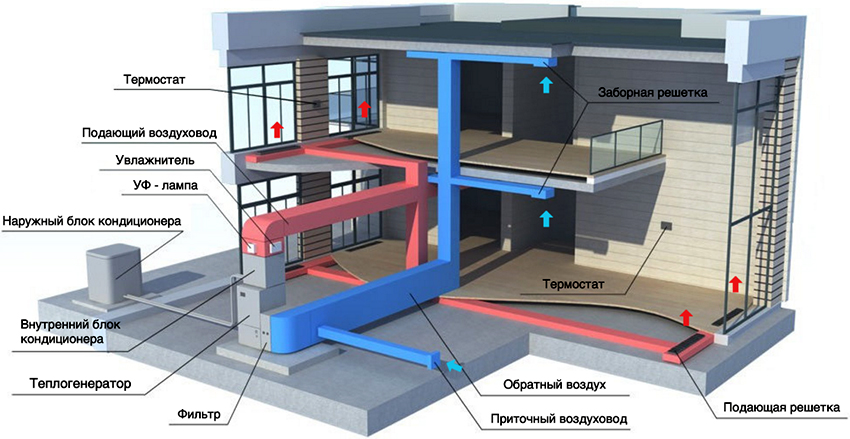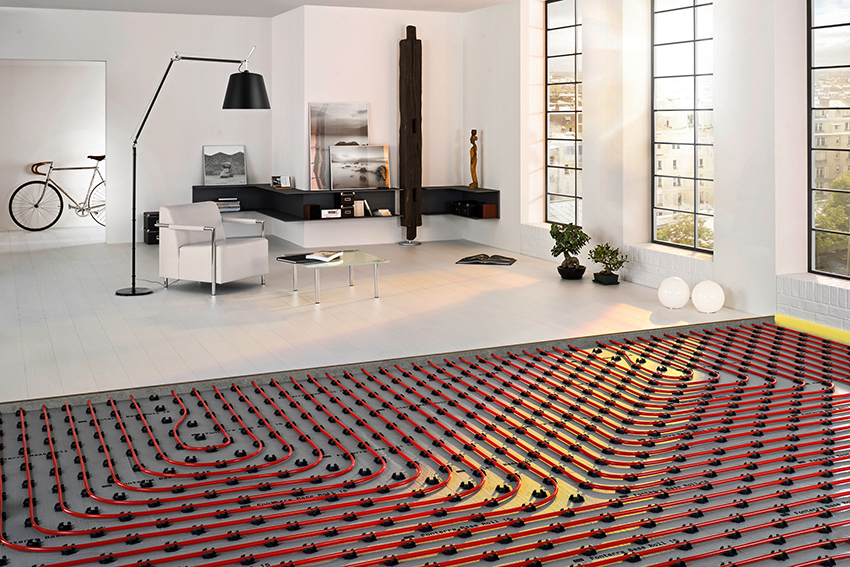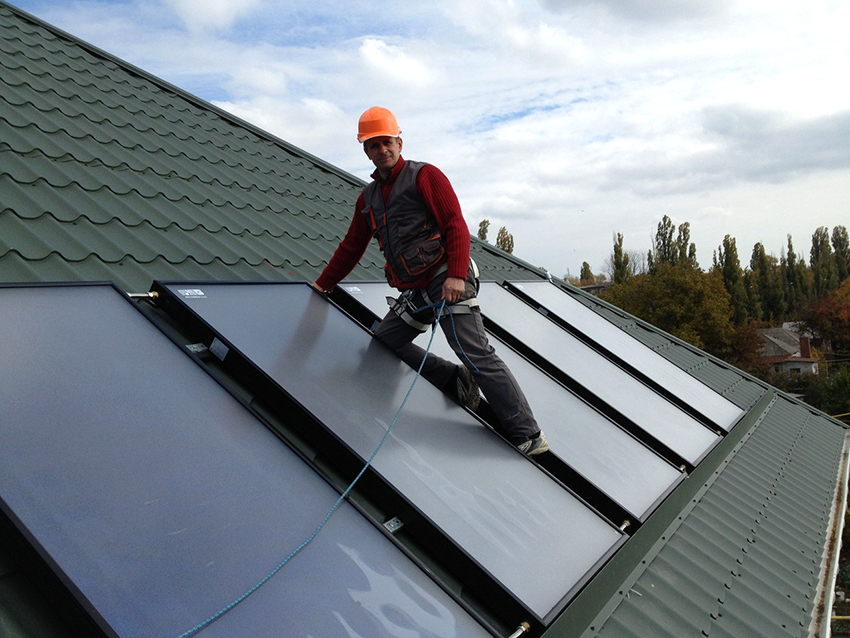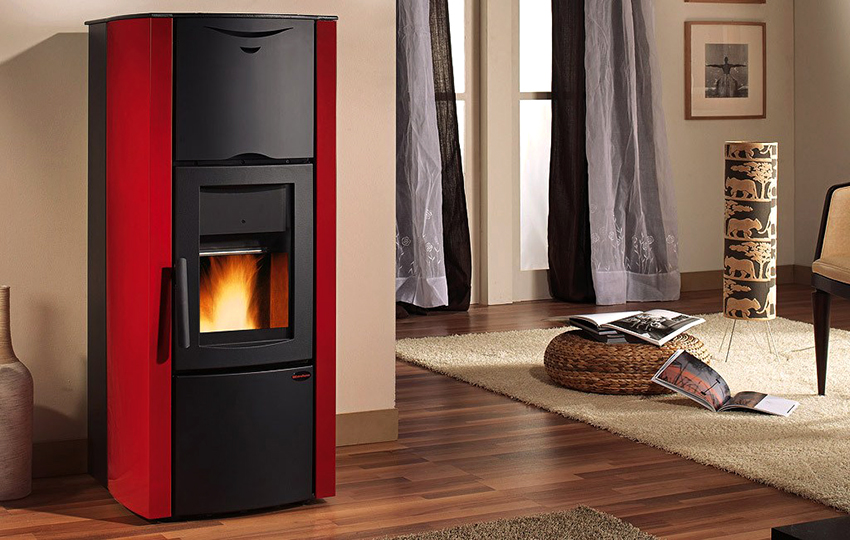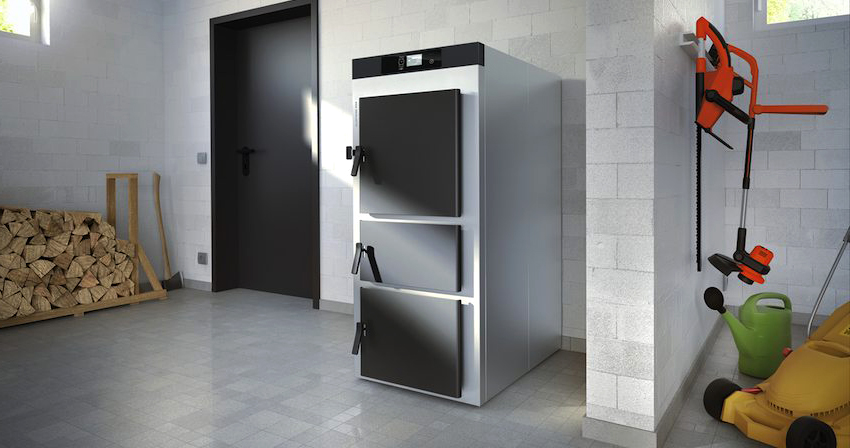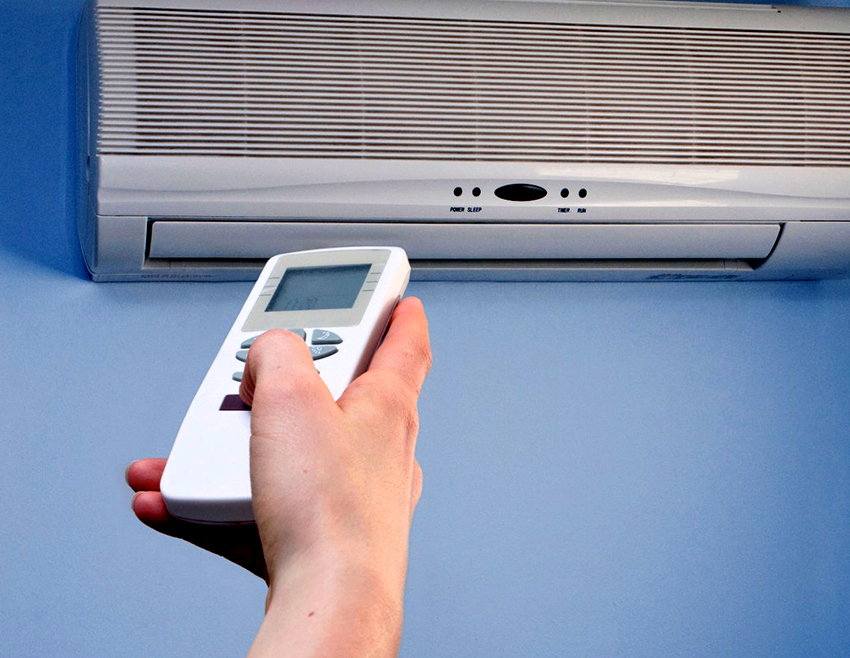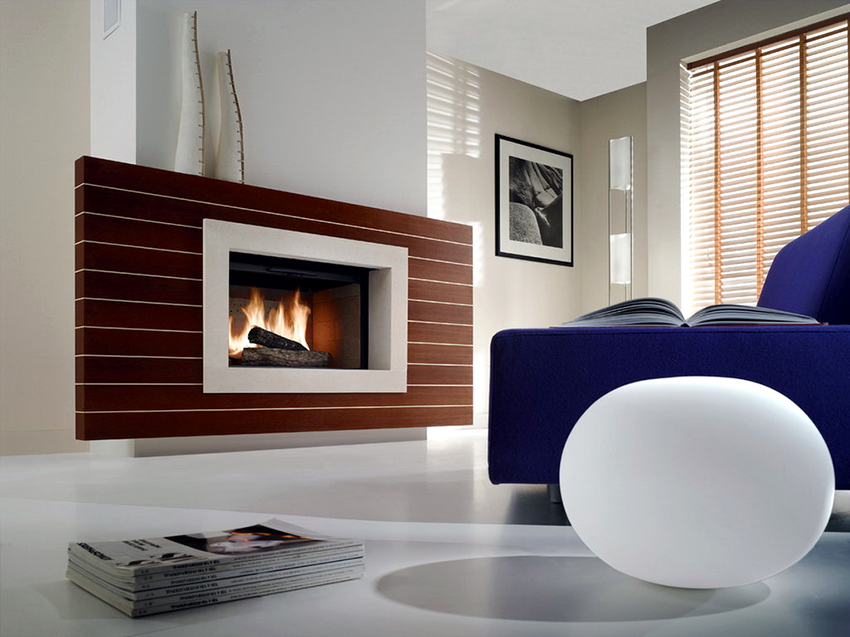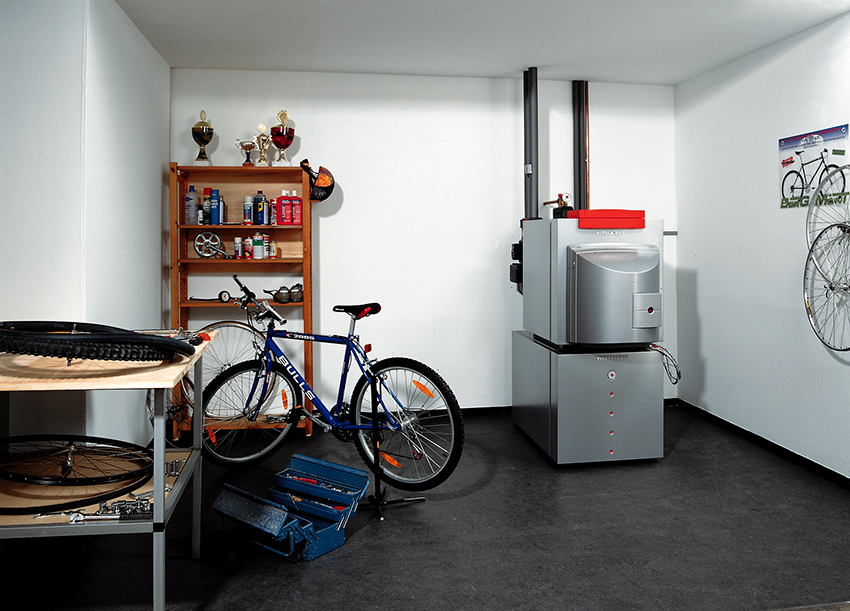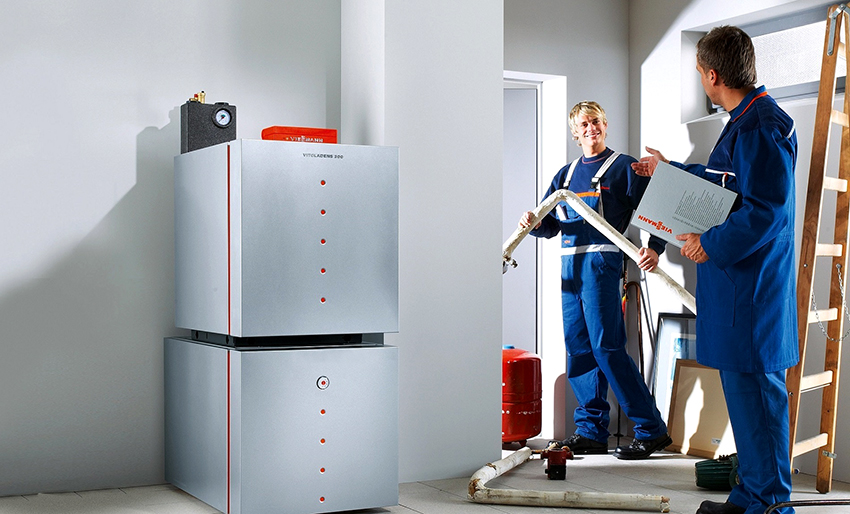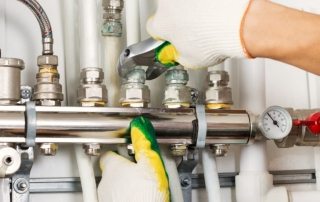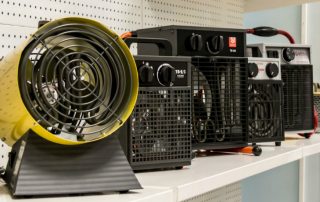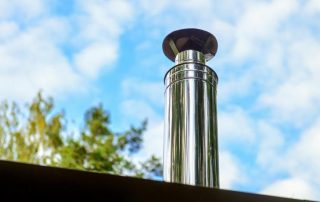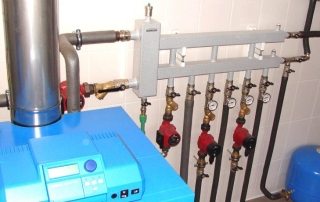The quality of life largely depends on the comfort of the indoor microclimate, especially in the cold season. One of the most important indicators of convenience is temperature. Its increase in residential buildings and industrial buildings is carried out through the use of thermal energy. There are several heating methods. And among them is the increasingly popular air heating system.
Content
- 1 Air heating of premises: an excursion into history
- 2 Classification of air heating and ventilation systems
- 3 Equipment for air heating of a private house
- 4 Types of heat generators for air heating
- 5 The principle of operation of a solid fuel air heating boiler
- 6 Gas air heating equipment, its functioning
- 7 Calculation of air heating: basic indicators and requirements for them
- 8 Operational features of air heating Volcano
- 9 DIY air heating of a private house
- 10 Air heating systems for industrial premises
- 11 Air heating system of a private house: an alternative to expensive heating
- 12 Air heating of a private house, reviews: unity and opposition of opinions
- 13 Air heating system: new possibilities
Air heating of premises: an excursion into history
If we turn to the history of the development of mankind, then we can confidently state that the first methods of heating a dwelling were carried out with the help of air: an open fire was made in the cave. Then, with the advent of a real home, man began to create air heating systems.
The first written description of such a system (hypocaust) appeared in the 1st century BC. e. Its author was the Roman architect Vitruvius. Heating was carried out in two stages. Outside the room, a stove was laid out, hot smoke through the outlet ducts entered the floor and into the walls. After the stove was extinguished, the smoke channels were closed. However, others were opened, through which air entered from the outside, passed through the oven, heated, fresh and warm into the dwelling.
So it would be wrong to talk about creating modern, completely new air heating systems. The existence of such heating, and even with the use of ventilation, goes back many centuries. Hypocaust was a rather expensive system, so it was only available to the rich.
The next epoch, significant for the development of engineering, dates back to the 15th century; it gave mankind a Russian stove.The air was in direct contact with the heated surface, reducing heat loss and increasing efficiency. The price of air heating has dropped significantly and the efficiency has increased.
Further, air heating systems were gradually modernized and improved. Stoves began to be made not only of stone, but also of various types of metal. Pumps, fans were introduced into the systems, air was purified and humidified. They began to use automation, electronic control.
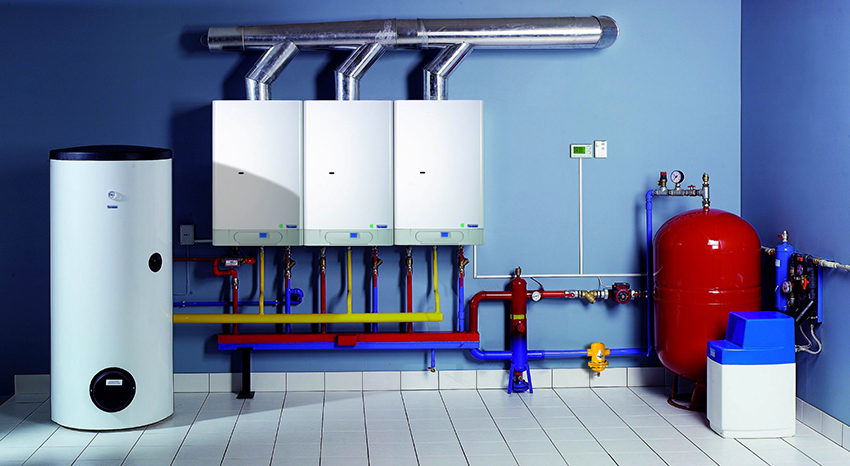
In the 20th century, fans, air conditioners, pumps and electronic control began to be introduced into heating systems.
Classification of air heating and ventilation systems
There are several modern home air heating systems. Their classification is based on the method of air circulation, depending on the characteristics of the devices used, air exchange and the location of the structure. By the way of air circulation, there are:
- Mechanical systems. The movement of the air flow through the air ducts is provided by fans.
- Systems based on natural circulation. The temperature difference, the presence of heated and cold streams ensure the movement of air masses (according to the laws of physics).
Classification by device type:
- Central systems. Designed for heating large premises.
- Local. Provide the required temperature in individual rooms or zones.
Depending on the method of air exchange used, the systems are divided into the following types:
- Recirculating. Only the air of the heated room is used.
- Partial recirculation designs.
- Supply air. The air intake is carried out from the street.
By location they are distinguished:
- floor devices;
- suspended structures.
Each of the systems differs in the number of components, installation method and operational characteristics. Floor standing mechanical recirculation is the most affordable type of system. Providing an external air flow requires auxiliary devices, thereby complicating installation and attracting additional financial investments.
Helpful advice! Before choosing a room air heating system, you need to consult with a specialist who knows the features of housing construction, where you plan to install heating.
Equipment for air heating of a private house
The mounted air heating device is a central air conditioning system that provides round-the-clock heating and air circulation that maintains the set temperature in the room. Traditionally, an air heating system consists of the following main parts:
- air heater;
- fan;
- air ducts;
- additional modules.
The main mechanism of the air system is the heaters. They can be of two types:
- Heaters, duct units. The air heats up at the time of ventilation, passing through the heated ducts.
- Heat generators. They heat the air by burning various types of fuel.
Air heating in a private house, in industrial premises is equipped with fans that provide cold air intake and warm air movement. They differ in power, principle of operation (blowing and exhausting) and productivity. Air ducts can have two purposes:
- supply air (supplying air to heating devices);
- reverse (transporting already heated air).
Installation of air heating systems involves the placement of air ducts under a raised floor, above a false ceiling, in ceilings and walls.
Many such systems have auxiliary modules, the purpose of which is additional air purification and humidification. Filters are used to clean the air.More often it is a multistage device that first captures large particles, then a plastic electrostatic layer retains smaller (up to 0.01 microns) components, and a coal mechanism that removes odors lets fresh and warm air into the room.
Modern equipment for air heating, presented on the domestic market, is equipped with steam humidifiers, which are installed behind the air heater. They have a sensor that regulates the degree of humidity in the room.
Types of heat generators for air heating
A heat generator is an air heating unit that produces heat energy by burning one of the types of fuel. Power, efficiency, installation method, operating features are largely determined by the type of fuel. For heating living quarters, social facilities, the following types of units are mainly used:
- Pyrolysis boilers. They work on solid fuels of plant origin (wood, woodworking industry waste, pellets, briquettes, peat).
- Gas boilers. Natural gas is burned.
Helpful advice! Before installing an air heating and air conditioning system that assumes a long service life, it is necessary to correctly calculate the fuel resources. Switching to another type of fuel requires an almost complete replacement of the system.
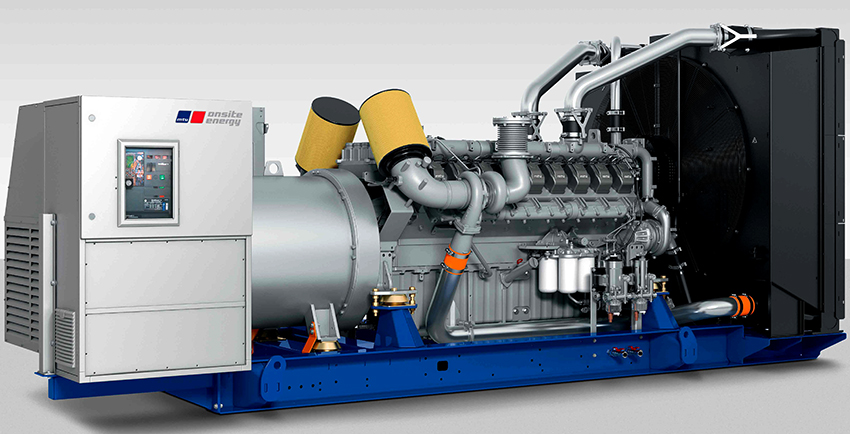
For space heating, pyrolysis or gas boilers, as well as diesel and universal heat generators can be used.
For air heating of large production areas, the following types of generators can also be used:
- Diesel. They run on diesel fuel. Their refueling is carried out once a day (this is an average indicator, there are models that may not refuel for 2-3 days).
- Universal heat generators. Diesel is also used as fuel for them, as well as oil waste, vegetable fats to be utilized.
These fuels are cheap, which significantly reduces the economic costs of enterprises for heating industrial premises.
The principle of operation of a solid fuel air heating boiler
The basis of any heating system is the heating unit. For the air system, this can be a solid fuel boiler. The main fuels for this type of heater are wood and wood waste. A solid fuel boiler traditionally includes the following elements:
- Firebox. A chamber in which the combustion process takes place directly.
- Luke. Through it, wood is loaded into the firebox.
- Grizzlies. The grate through which ash and unburned fuel residues spill out.
- Podzolnik. Located below the firebox. It is in it that combustion residues accumulate.
When choosing a boiler for air heating for a private house, the pyrolysis type is often preferred. This heating structure has two combustion chambers. In one, the main fuel is burned, and in the second, when combined with oxygen, wood gases are ignited, releasing a large amount of heat. In inexpensive solid fuel boilers, air is supplied manually. More expensive models have fans that turn on automatically. To improve the efficiency of the boiler, the chimneys are equipped with smoke exhausters, whose task is to remove combustion products from the furnace as much as possible.
For convenient and safe use, modern models of solid fuel boilers can be equipped with additional devices:
- automatic ignition;
- air blowers;
- temperature sensors that regulate the combustion process;
- devices that supply fuel.
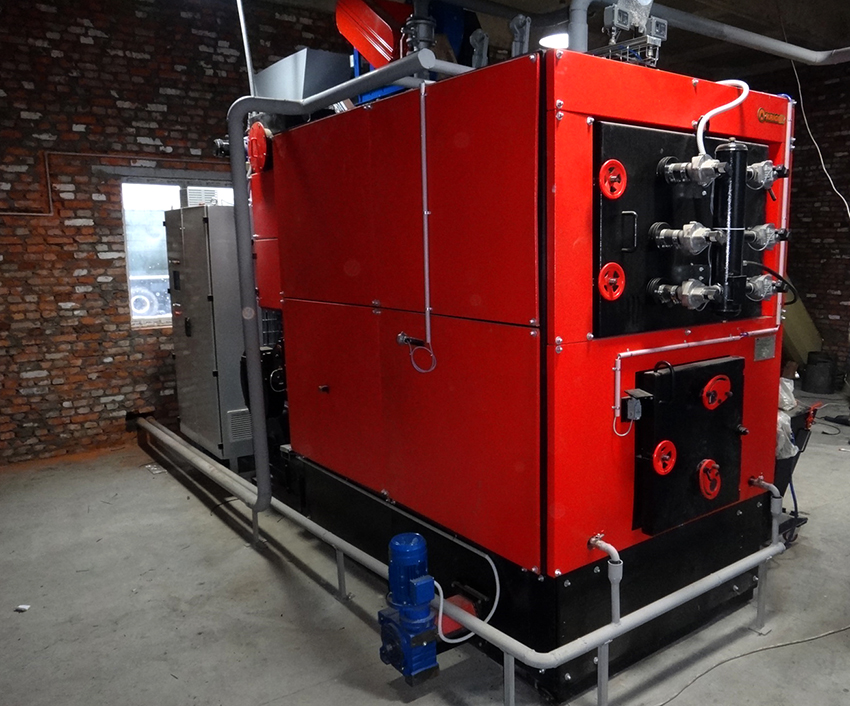
Modern solid fuel boilers are equipped with an air blower, temperature sensor and automatic ignition
Important! For a system in which the air ducts are located in the lower part of the room, you will definitely need a boiler with forced air circulation.
Gas air heating equipment, its functioning
Quite often, gas boilers are installed as heat generators in air heating systems. In this case, the fuel is mainly main gas (switching to propane-butane requires re-equipment of the burner). The principle of operation of these units is as follows: burning, the gas heats up the heat exchanger, through which the air is forcedly driven, which then enters the premises.
To install a gas boiler for air heating of a private house, it is necessary to obtain permission and make projects for connecting to the general input, wiring for housing construction. This documentation requires strict adherence to certain codes and specifications.
The main distinguishing characteristics of gas heating boilers are:
- high efficiency achieved by increasing the efficiency level up to 92%;
- moderate dimensions;
- low noise level;
- high degree of protection provided by sensors.
The advantage of gas as a fuel for an air heater is that it does not emit heavy harmful products like burning, ash, soot during combustion. Gas air heating systems are installed both in private houses and in industrial premises.
Calculation of air heating: basic indicators and requirements for them
Any heating system, and air in particular, requires correct and accurate calculations. The instructions for the heating units contain enough information from this plan. It is based on average statistical data and theoretical conclusions. When planning an air heating system, it is better to entrust the calculation to specialists with practical experience in installing installations.
Related article:
Solar collectors for home heating as an alternative source of energy
The principle of operation of devices. Varieties of products, their characteristics. DIY solar collector. Manufacturers and models.
The main indicators taken into account when calculating the system are:
- Air consumption for the heating system. The average rate is 1500-3500 m³ / hour.
- System pressure. It is 150 Pa.
- Boiler power. It differs for different models and types.
- The amount of heat loss. This indicator depends on the characteristics of the technical conditions of the room.
Heat loss can be calculated using the following formula:
Q = S * T / R, where
Q - heat losses;
S is the area of the room (or building);
T is the difference in temperature indicators outside and inside;
R is the thermal resistance of structures.
Illiterate execution of calculations can lead to the absence of the expected result and even significant negative consequences:
- during operation, the heat generator may overheat, the operation of the system as a whole will be blocked by sensors;
- the appearance of significant noise, vibration of air ducts is possible;
- there is a risk of disruption of the air exchange cycle, which leads to temperature imbalance.
The total length of the central air duct should not exceed 30 m. Additional branches - no more than 15 m. The power of a solid fuel boiler for heating a residential building can be 20-50 kW. To provide air heating for greenhouses, conference rooms, halls, etc., boilers with a capacity of up to 1 MW are used. Production workshops, shopping centers can provide heat to devices with a capacity of 5 to 10 MW.
Helpful advice! When choosing a boiler for air heating, it is better to give preference to a unit that has the ability to regulate the combustion process. The cost will quickly pay off with economical fuel consumption.
Operational features of air heating Volcano
All air heating systems are divided into local and duct. The local design involves the installation of a heat source directly in the room that needs to be heated. The equipment only heats the air around it. The duct system provides for the transportation of warm air to other rooms. Vulcan is a highly efficient local air heating system. The equipment is manufactured by the Polish company EuroHeat. It is a connection between a water heater and a fan. This system is recirculating, it does not imply outside air intake.
The heat carrier of this unit is hot water. It must be supplied from an uninterruptible source, the temperature of which does not exceed 90 ° C. With the help of an axial fan, the air flow is sucked in, passed through the heat exchanger and supplied back into the room, already warm, distributed by the guiding louvers. The unit is controlled automatically, that is, switching on and off is controlled by sensors that fix the upper and lower thermal thresholds. Among the positive features of this type of air heater, it is worth highlighting:
- Silence. It is ensured by the shape of the blades and the high quality of the fan bearing.
- Strength of structural elements. For the manufacture of the case, polymers resistant to mechanical stress and high temperature are used.
- Ease of installation. It does not require special conditions, the connection diagram is attached to the unit and is available to everyone.
- Reasonable cost.
This type of air heaters is used for large premises. In total, the company produces 6 models, differing in power, dimensions and number of blinds. The manufacturer attaches great importance to the appearance. Volcano units not only do not spoil the interior, but can also become part of the design.
DIY air heating of a private house
It is quite affordable to make your own air heating. If this is done at the construction stage, and not in the finished building, then the goal becomes even more achievable. To understand how to make air heating in a private house, you first need to determine the desired result, and then technically calculate the possibility of achieving it. Calculations are the primary step in this process. The algorithm of actions for self-organizing air heating can be as follows.
First, you need to perform calculations:
- the amount of warm air;
- heat loss;
- capacity of the required equipment.
These calculations are best done (if there is no knowledge and personal experience) with the participation of a practitioner.
Helpful information! In the presence of good modern thermal insulation, it is possible to take into account the following practice-tested indicators in the calculations: 750-800 W of heat is needed per 10 m² of the room area.
Then, based on the calculations of the project, an air heating scheme is created. It should reflect the location of the system elements, the power of the main unit, the diameter of the air ducts, etc. You can use the schemes proposed on the Internet, but only if the technical conditions are suitable. Changes to finished drawings must be made with great care.
After that, equipment is purchased.At this stage, attention should be paid to the certification of the equipment and the content of the instructions. In addition to the main units, you should purchase air ducts (preferably flexible, noise-absorbing). To prevent the accumulation of condensate, the supply branch should be insulated with insulation. For these purposes, it is recommended to use foil insulation with a thickness of up to 5 mm. It is convenient to use tape to connect the air ducts. Reinforced aluminum is a good option. Clamps made of metal or heat-resistant plastic are also suitable.
Next, the direct installation of the system is carried out. It must be carried out before finishing work. If the heating is installed in a room with a finished finish, it is worth paying special attention to the aesthetics of the boxes that close the air ducts.
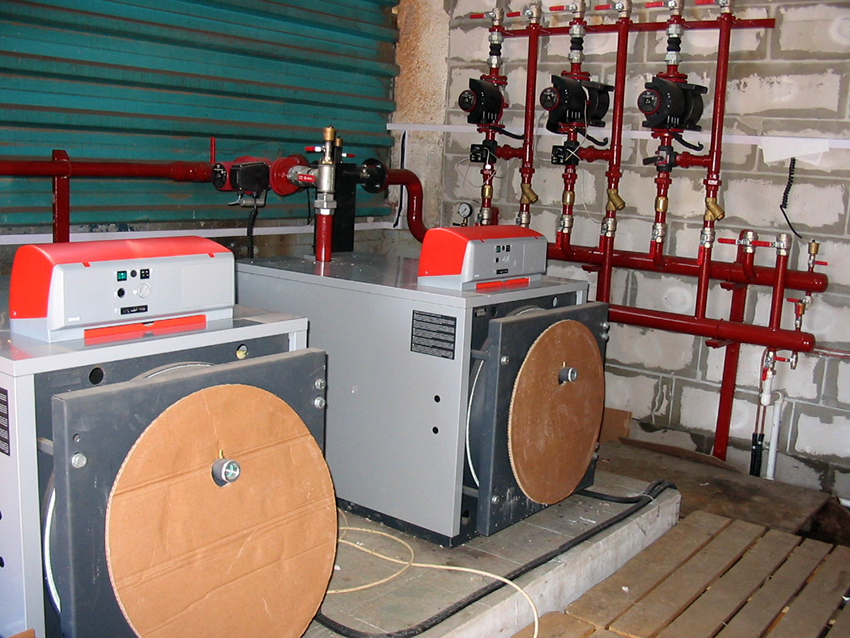
If you have the skills, then the installation of the air heating system can be done with your own hands
Air heating systems for industrial premises
The air heating system of an industrial premises does not have significant differences from a similar method of heating a private house. The same heaters, heat generators, fans can be used. The only difference lies in the large size of the premises, which require corresponding equipment capacities.
When designing heating systems for industrial premises, an important point is compliance with fire regulations and rules. Depending on the operational features of production areas, it may be prohibited to place gas heat generators in them. In such cases, they are taken out of the premises. Diesel generators are actively used for air heating of production facilities. They are distinguished by their high power, allowing the installation of branched duct systems.
A special indicator when performing an air heating system scheme is the height of the ceilings. Warm air must be directed to the desired area of the room. Fan heaters are best suited for this task. Using these units for heating has the following advantages:
- quick, low-cost installation (fan heaters are mounted on walls or ceiling), it can be performed by the company's employees;
- there is no need to lay heating mains and air ducts, therefore, small investments will be needed;
- the ability to direct warm air flow to the desired area;
- does not require constant monitoring and maintenance;
- low noise level, which is relevant for many types of industries.
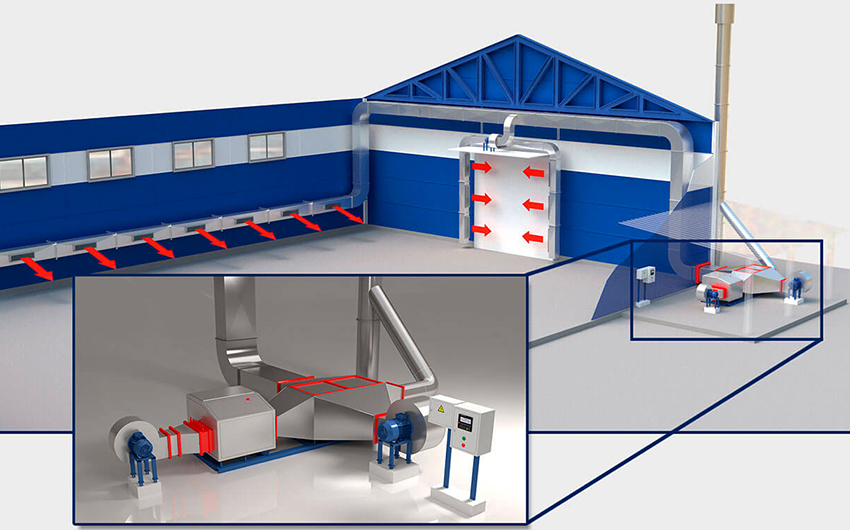
When designing a heating system for a production facility, it is important to comply with fire regulations
Air heating by ventilation is characterized by a minimum level of heat loss and energy consumption. In addition to heating, it is also used for drying timber and other materials on an industrial scale. Heat guns are also used to heat industrial premises. Such devices are connected to a voltage of 380 W. The heated air is delivered in a targeted long-range powerful stream.
Air heating system of a private house: an alternative to expensive heating
The philosophical statement "Everything is learned in comparison" is quite applicable to understanding the advantages and disadvantages of such a technical object as a heating device in a house. Air heating can be compared to water heating, which is most often used to heat living quarters. Without delving into the indicators of capacities and operational characteristics, we will draw up primitive systems diagrams:
- water heating: boiler - radiators - air;
- air heating: heat generator (or heater) - air.
The interaction of heat with air in the second case is carried out in a shorter way. Consequently, heat loss is minimized, the amount of fuel for heating the air is reduced.The disadvantages of the water system include inert air circulation, as a result of which air exchange between the warm upper layers and the cold lower ones is slow.
Similar comparison results can be obtained when comparing the air system and the "warm floor" heating method, which uses both water and electricity. Both water and electricity first heat the floor, and only then the air in contact with it. Moreover, the second heat source will also require significant electricity costs.
Helpful advice! When choosing one or another type of heating, it must be borne in mind that the air system can perform, in addition to heating, and air conditioning the room.
Free energy use: air solar heating
Solar energy is used today both on an industrial scale and for the life support of private houses. Almost every home-building owner can use this free source, in particular for space heating. Financial costs are required only for the purchase of equipment and installation of air heating. The system as a whole is quite simple and consists of an external unit, which is a flat box, arranged as follows:
- walls are made of wood-based panels or plywood;
- the bottom is made of black painted corrugated board. The applied paint must provide intense light absorption;
- glass or transparent polycarbonate cover.
Solar energy heats the air in the duct, which is supplied to the room by a fan. The simplicity of the design and the availability of materials allow you to mount a solar air heating system at home with your own hands. This type of heating has undeniable advantages:
- low cost;
- high efficiency;
- no danger of overheating or hypothermia (the material of manufacture is heat-resistant, the absence of liquid eliminates the problem of freezing).
The collector should be located on the roof on the south side, where solar energy is concentrated to the maximum. Solar air heating cannot provide space heating throughout the season. Rather, it can be a supplement to the main heating. However, in the spring-autumn period, it will fully meet the needs, while significantly reducing the financial costs of heat carriers.
Air heating of a private house: pros and cons
The information above in this article reflects to a greater extent the positive characteristics of this heating system. The growing popularity of this heating method is evidence of its efficiency, affordability and environmental sustainability. The general list of benefits should be supplemented with a few more:
- air heating allows you to organize zoned distribution of warm air;
- duct pipes are not subject to corrosion;
- in the winter season, such a system does not require special control.
Once again, it is worth noting that a significant advantage of an air heating system for a private house is the price. Its decrease is not so much due to the cost of equipment, but due to the ease of installation and the absence of the need to prepare project documentation (unless a gas heat generator is used). However, an objective assessment is that there are advantages and disadvantages inherent in an air heating system. These designs have the following drawbacks:
- after stopping the heater, the air cools down quickly enough;
- the efficiency of the system depends on electricity, since the air flows are blown by a fan powered from it;
- without installing filters, air into the room will be supplied with dust particles and unnecessary impurities;
- The heat generators installed in the building take up a lot of space and do not always fit into the interior.
Helpful advice! If power outages occur frequently enough, it is worth purchasing a UPS for stable fan operation.
Air heating of a private house by air conditioning
Inverter air conditioners can also be used for space heating. Their cost is almost twice the price of similar units that perform the function of cooling. When using an air conditioner, there is no need to design an air heating system. The air is heated in the outdoor unit, then it is transmitted through the channel to the indoor unit and is directed into the room with the help of a fan. The operational capabilities of such an air conditioner are limited.
The outdoor unit cannot operate at temperatures below -7 ° C (the figure may differ in individual models). A conventional split system provides comfortable indoor conditions in the autumn-spring period, when the central (or autonomous) heating has not yet been turned on or has already been turned off.
Helpful advice! When using a split system for heating, the temperature level specified in the instructions must be strictly observed. The most common consequence of a non-compliance is a burned-out compressor.
For year-round use, air conditioners with heat pumps are suitable. Such units provide air heating and air conditioning even at -25 ° C. If in a conventional air conditioner during heating, electrical energy is converted into heat energy, then the pumping system pumps warm air from one medium to another. That is, during cooling, excess heat with the participation of a refrigerant is thrown out into the street - during heating, everything happens exactly the opposite: warm air raises the temperature of cold street air.
Air heating of a private house from a stove
In some areas where there is no centralized gas supply and wood is an inexpensive fuel, it is advisable to use a stove as air heating. This outdated way of heating housing is perceived in a new way today:
- the constructive combination of the stove and fireplace contributes to the creation of a cozy interior;
- the environmental friendliness of the material used for masonry and the naturalness of the fuel create a comfortable atmosphere in the room;
- the oven can be used not only for heating, but also for cooking.
The main disadvantages inherent in this type of heating are:
- low efficiency rate;
- large heat losses due to the chimney;
- long time to warm up the oven;
- dependence of the amount of heat on the size of the stove;
- uneven distribution of warm air throughout the room.
To heat a 25 m² room, a 1 m² stove is required.
Helpful advice! If the area of the room is more than 30 m², then it is better to use coal as fuel for heating it. It generates more heat, so it will take less time and less fuel to heat the air to the desired temperature.
When using the stove as an air heating system for a building with several rooms (more than three), for high-quality heating of the premises, an additional heat carrier is needed - possibly water.
Air heating of a private house, reviews: unity and opposition of opinions
“I made the air heating myself in the country. Only 2 rooms, 42 squares. The boiler took the BPS, the weak one - by 15 kW. I installed it myself. I ran three canals, just along the wall and up: one goes where the boiler is, and two into another room. Didn't close them in any way. The appearance does not bother, even interesting. The house, or rather the air, heats up immediately.But things, walls are heated for a long time. We live there fickle, we have to wait a day for everything to become warm ”.
Evgeniy, Orekhovo-Zuevo
“Air heating for the second year. I counted on everything, provided for, I gave a third of the price of all heating for the scheme. Until this year the house was insulated, it was cold. Despite all my efforts, the temperature in the house did not rise above +16 ° C. Now, in the coldest back room, +19 ° C. With air heating, the house must be airtight, then there will be a result. "
German, Kursk
“Air heating as a fan heater. While it works - it's warm, turned it off - and it's cold right away. And there is no hot water, separate heating is needed. Better batteries, and the old type, cast iron: both heat and dryer. "
Roman, Yekaterinburg
“If you make high quality air heating, it costs a lot of money. I have a 102 m² house. It took almost a week to lay the canals. I made the boiler room separately. The house is warm, the temperature is quickly regulated. The old apartment had batteries, the same in terms of efficiency. The fact that the walls are free is good. With regard to gas, savings are felt. "
Vyacheslav, Belgorod
Analyzing the reviews, we can conclude that everyone determines the advantages and disadvantages based on personal preferences and expectations.
Air heating system: new possibilities
The air heating system is just beginning to gain its place among other engineering projects in the field. It is no coincidence that there are conflicting opinions about the degree of complexity of installation, the quality of equipment, and efficiency. Even the price of air heating of a private house is considered by some to be affordable, by others - prohibitively high.
The lack of consistent valuation definitions or trends is due to insufficient time period of use. The task of any heating is to heat the air in the room. Does the system described above provide new opportunities? Certainly. Two features in the operation of the system can be considered a technical achievement:
- The air is heated directly, bypassing the metal of the radiators and the water in them.
- There is a possibility of regulating the power of air flows. The dampers can be used to increase or decrease their supply to individual rooms or zones.
Home comfort is largely determined by the temperature and air condition. If a heating system can not only quickly heat it up, but also clean, humidify and distribute it, it will surely find widespread use.
